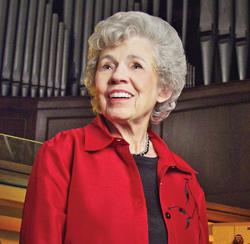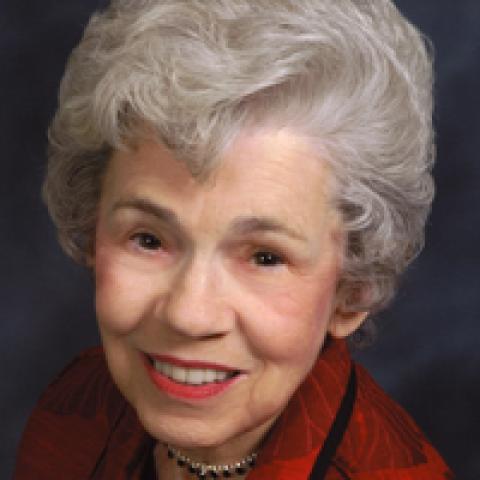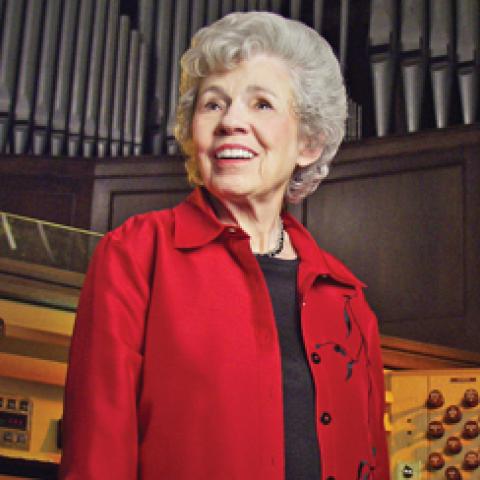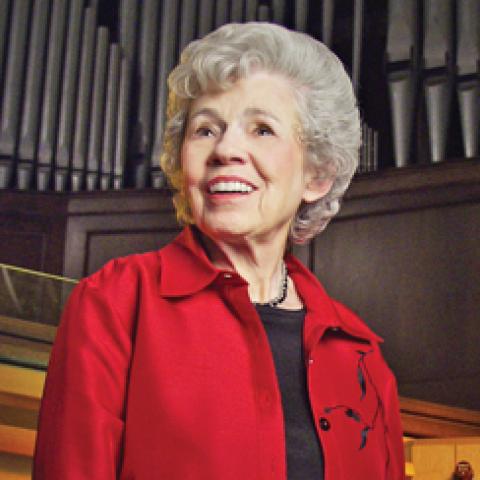Wilma Jensen is heralded as an outstanding recitalist, church musician, and teacher. Her extensive concert career has taken her throughout the United States. She has played on countless well-known instruments, including those at First Congregational Church in Los Angeles, the Mormon Tabernacle in Salt Lake City, the National Shrine of the Immaculate Conception in Washington, D.C., Riverside Church in New York City, St. Paul’s Cathedral in St. Paul, St. Philip’s Cathedral in Atlanta, and the West Point United States Military Academy. Having played for several regional conventions and three national conventions of the American Guild of Organists, she is in demand as a recitalist, lecturer, and clinician for choral workshops, church music workshops, and organ masterclasses. Numerous European tours have taken her to Norway, Sweden, Denmark, Germany, France, Poland, the Netherlands, and England. In addition, she has made a recording for West German Broadcasting, Sender Freis Berlin.
Dr. Jensen earned her Bachelor and Master of Music degrees from the Eastman School of Music in Rochester, New York, where she was a student of Catharine Crozier and Harold Gleason. During that time she received the Performer’s Certificate in organ. She received an honorary doctorate from Piedmont College in May 2004. Recognized as a successful teacher, Wilma Jensen has served on the faculties of Oklahoma City University, the Blair School of Music of Vanderbilt University, Scarritt Graduate School, and Indiana University, where she was a tenured professor.
In addition to two professional solo recordings—Mors et Resurrectio (Arkay label) and Sketches and Improvisations (Pro Organo label)—Wilma Jensen also made two recordings conducting the St. George’s Choir on the Pro Organo label. She has given numerous masterclasses around the country at sites including the Juilliard School, Curtis Institute of Music, Westminster Choir College, Eastman School of Music, and many others. She has a full upcoming schedule of recitals and masterclasses and will present a pre-convention recital for the 2012 AGO National Convention in Nashville. Additionally, she will teach two workshop masterclasses. For more information, go to www.wilmajensen.com.
Andrew Peters: You’ve had a lengthy career in the organ world. What first interested you in the organ?
Wilma Jensen: My father was a Methodist minister in south central Illinois. By the age of ten, I wanted very much to try the organ, having started piano lessons at age five. Of course I was in church every Sunday and could play many hymns on the piano at a very young age, as well as do some playing “by ear.”
AP: You’ve had experiences in three aspects of the organ world: church music, teaching, and performance. Can you talk a bit about your experience with service music and hymn playing?
WJ: When I was twelve, I had a regular job on a two-manual pipe organ in my father’s church, since there seemed to be no one else to play. I have no memory of what I might have used for voluntaries. They were probably poor, but I did enjoy working out the hymns with pedal, although at this point I was self-taught. I was extremely proud of my salary of $1 per week! A well-known organist, Dr. Frank Collins, gave a recital in my hometown, and my parents asked him to hear me play. He suggested I should study with a good teacher and recommended Ruth Melville Bellatti at MacMurray College in Jacksonville, Illinois. She was a graduate of the Eastman School of Music, having studied with Harold Gleason, and was a classmate of Catharine Crozier. She insisted I play every note of the first edition of the Gleason Method. Also, she was instrumental in my attending Eastman for undergraduate and graduate study.
AP: You had a long tenure at St. George’s Episcopal Church in Nashville. Did you have a choral background before serving there?
WJ: Unfortunately, no. I conducted only one other church choir for a short time before coming to St. George’s. I realized I was in no way ready for the position, so I sought out excellent teachers to help me with conducting, diction, and repertoire. (This happened over a number of years.) Lois Fyfe and her staff at Lois Fyfe Music in Nashville provided invaluable assistance for the selection of choral music. An associate priest at St. George’s spent hours helping me each week in the study of the church year and planning appropriate music for the specific Sunday lessons from the Lectionary. Also, I listened to and studied numerous recordings of choirs from all over Europe and the U.S.
AP: Did studying choral skills in your mid-life give you a unique perspective on choral music and the voice?
WJ: Yes, it certainly did. Conducting makes one so conscious of the “time and dynamics between the beats,” the shaping of the musical line, and the timing of consonants for perfecting ensemble. Unifying proper vowels contributed more to the beauty of the sound than I ever previously could have imagined.
During my tenure at St. George’s, the choir made two recordings and was chosen from an audition tape to sing for the national convention of the American Choral Directors Association in 1989. By that time, I had been choirmaster/organist for seven years and had been studying and growing as a musician. That summer, the choir made an extended tour of Europe, singing in England, Austria, and France. Our tour concluded at the Cathedral of Notre Dame in Paris, where we sang a pre-service a cappella program prior to singing the Vierne Messe Solennelle at Sunday morning Mass. (I also played the afternoon organ recital.)
AP: You’ve played recitals on organs of various historic periods throughout the United States and Europe. Out of the hundreds of recitals you’ve played, do any stand out in your mind?
WJ: I am very grateful for the experience of playing so many diverse instruments, both electro-pneumatic and tracker. Some have been in large cathedrals with much reverberation and some have been small historic instruments. I appreciated being able to play the first Cavaillé-Coll of 1850 in Paris at the Cathedral of St. Denis, as well as later instruments of the same builder. At St. Denis, because the pedal pipes are so far from the console and there is no Barker lever for the pedal, I had to stand on final long notes with all the weight I could manage in order for all the pipes to sound! I enjoyed playing an Åkerman instrument in Uppsala, Sweden (Åkerman was a pupil of Cavaillé-Coll), a Schnitger organ in Germany, St. Paul’s in London, and many small tracker instruments in the Netherlands. I must admit I love a reverberant cathedral sound. This wide variety of experiences helps in my understanding of the overall repertoire and my ability to communicate appropriate registration to students. I do enjoy spending time planning the registration.
AP: You’re continuing to learn new repertoire. Do you have a particular style, period, or composer in which you specialize?
WJ: I especially enjoy learning, performing, and registering the Romantic and contemporary literature. Additionally, I keep exploring repertoire for voluntaries for services, both for myself and students, and occasionally substitute for services at St. George’s and other churches. I have been given some out-of-print repertoire, which I later performed and recorded. As a result, several of these compositions now appear as archival editions. I am so looking forward to playing soon the newly renovated 1932 Aeolian organ at Duke Chapel. I have just learned all three of Eric Delamarter’s Nocturnes and will use the Chimes, Harp, Celesta and many solo stops as indicated in the score.
AP: You have current and former students across the country. Are there students with whom you are still in touch?
WJ: There are too many to name! Some are high-profile professionals. I am equally proud of many other students who are making invaluable contributions in their current positions. I stay in touch with many former students and enjoy hearing about their teaching, church positions, and performing. You might say talking on my cell phone to former students is my hobby!
AP: Do you still teach a monthly masterclass in Nashville?
WJ: Yes, I did teach a monthly masterclass for many years for anyone who wanted to attend. This season, however, I am so busy with recitals, classes, and other commitments that, at least for the moment, I am taking a break.
AP: You recently released an extensive teaching video and booklet, “Organizing Notes in Space.” Why did you start this project?
WJ: This project was important to me to help communicate some of my teaching concepts as part of my legacy. After considerable study of the physical aspects of keyboard technique, I have developed an approach to help students overcome problems and develop a facile technique. And, of course, one arrives at a satisfactory musical result only through a controlled technique. As a result, I wanted to demonstrate these ideas by teaching former students in a video.
AP: Is it true that you once played in a masterclass for Bonnet?
WJ: Yes, I played in a masterclass for Joseph Bonnet when I was twelve. I thought it was a recital, not a class. Since I was the first to play, I was humiliated that he stopped me for his suggestions. At the conclusion of my playing, I went to a corner in the back of the room and shed many tears.
AP: Besides being a past dean of the Nashville AGO chapter, have you served in other AGO positions?
WJ: In addition to being Dean-elect and Dean for the two-year period, I have served on many program, executive and education committees through the years. Also, I have judged competitions, taught at Pipe Organ Encounters—both beginner and advanced—and taught masterclasses throughout the U.S. I am on the workshop committee for the Nashville 2012 AGO national convention.
AP: What are your thoughts on the need for piano study before studying organ?
WJ: I think piano study is essential at a young age for developing a natural, flexible, facile technique. In mid-life, I had developed some wrist tension, too heavy thumbs, and resulting weak fourth and fifth fingers. I sought the coaching of Ernestine Scott, an incredible piano teacher in Oklahoma City. This study and extensive readings she recommended have changed my approach to technique and resulting musicianship. My new teaching video is dedicated to her. Sometimes when we are young we have a natural, facile technique that may change with lack of continued piano practice. Finding those skills again is a truly valuable gift at any age.
AP: Would you like to tell us a bit about your family?
WJ: I have two children, seven grandchildren, and five great-grandchildren. I frequently visit my daughter and her family near Chicago. The oldest two of three girls attend Indiana University School of Business, and I was able to visit them in Bloomington while attending conferences last year. My son lives in Orlando. His three girls and one boy are rather scattered geographically, but we all manage to meet in Orlando.
My daughter played the piano well and was fortunate to study with my teacher, Ernestine Scott. When she was in junior high, she was the registrant for my first European tour in Holland. She thought it was not as glamorous as she had expected! All seven grandchildren stomped their feet and said, “We are not taking any more piano lessons!”
AP: What changes in organ design have you seen during your career?
WJ: I recall experiencing the Orgelbewegung; then later Romantic organs including trackers, which became larger and larger; again more small historic trackers into the mix; and back and forth we go. I love it all!
AP: What do you perceive are the challenges of music in the contemporary church?
WJ: Just as we cannot seem to make up our minds about what kind of organ is best for each church, we seem to be having issues in choosing a traditional service with classical music or a contemporary service thought to be more appealing to young people. This issue has just come to the forefront at St. George’s in Nashville. The first modern liturgical service was just held a few weeks ago in a secondary worship space, which has been created with an altar, screens, microphones, etc. I attended the first service, and it was very successful and well done. I am pleased it was held in a place other than the main worship space. I believe it is essential to make the traditional service as beautiful, moving, and exciting as possible. The music of this new service was sensitive, set in a liturgical context, and still within the form of this modern style of worship. If that happens, there will be a place for both services to exist peacefully “in harmony.”
As for positions for church musicians, I believe if you can develop a really fine program that has meaning musically and spiritually, as well as make yourself invaluable to the program, there will be a good job for you.
AP: Thank you so much, Wilma!





